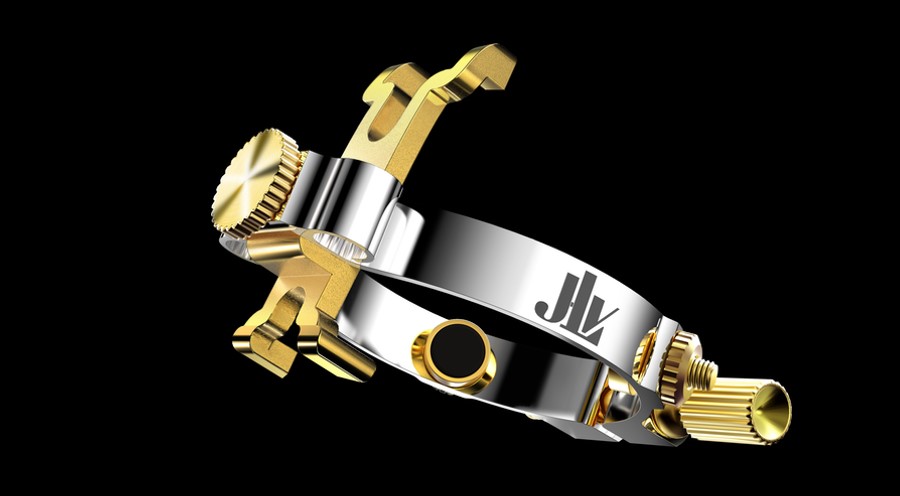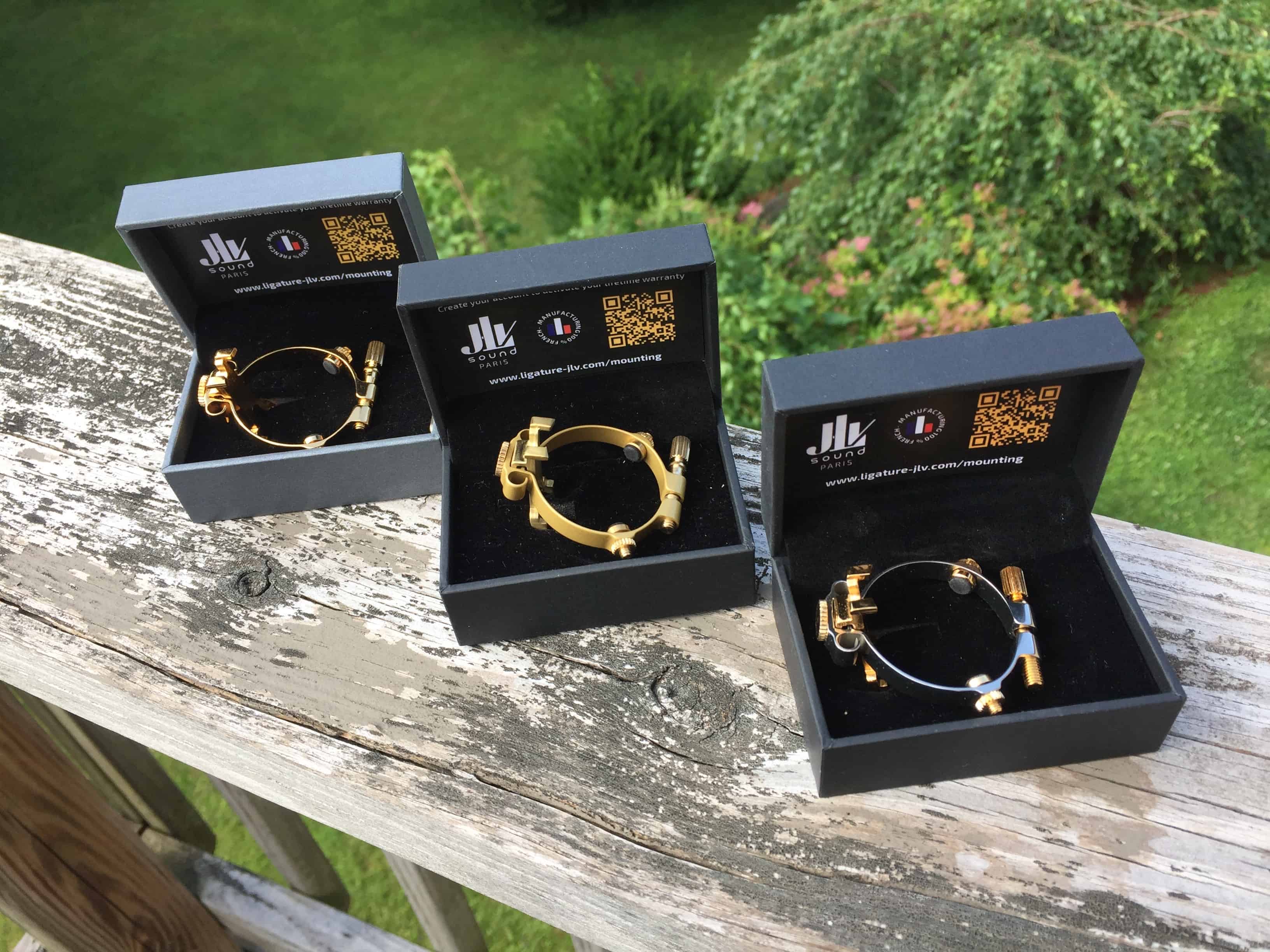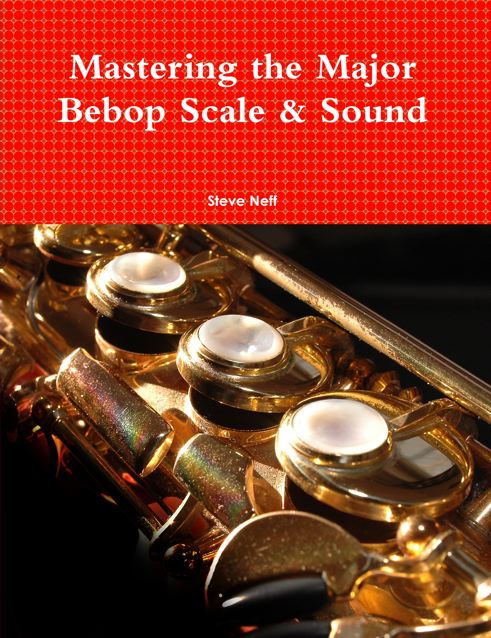Today, I am reviewing an innovative new saxophone mouthpiece ligature I received from JLV Sound in France. It is the JLV Sound Resurfacing Sax Ligature for hard rubber tenor saxophone mouthpieces.
This is not your everyday run of the mill saxophone ligature. I have included quite a few photos and even a video presentation of the JLV ligature to get a full understanding of how this sax ligature works and functions.
JLV Tenor Saxophone Mouthpiece Ligature
As you can see in the photos, this saxophone ligature by JLV Sound is really an innovative and technical creation that JLV has obviously spent a ton of time and thought in designing and creating.
JLV sent me three of these beautiful saxophone ligatures in three different finishes to review. I received a 24k gold finish, a silver and gold finish and a raw brass finish.
JLV Saxophone Mouthpiece Ligature
I first saw these cool saxophone ligatures on Facebook a number of years ago and was intrigued by their unique design and setup. Most mouthpiece ligatures are placed back on the bark of the reed but as you can see in the photo above, and the video below, JLV ligatures allow a sax player to place the front of their saxophone ligatures on the vamp of the saxophone reed as well.
The “old”, “set in my ways” part of my brain said this was foolishness. In all my years of saxophone playing, I have never seen or heard of this being done with a saxophone ligature. I must admit though, that the other side of my brain was intrigued by this and was very interested in trying one of these new ligatures out.
JLV Saxophone Mouthpiece Ligature Presentation Video
The three saxophone ligatures came in well made individual boxes that were lined with felt on the inside to protect the ligatures while in transit from France.
The ligatures looked very impressive and beautiful to me as I opened the individual boxes. Each box holds one ligature as well as a small metal wrench tool that can be used to adjust the screws that move the pads on the inside of the ligature that touch the saxophone mouthpiece. These were obviously created so that the JLV ligature pads could be adjusted for different size hard rubber tenor sax mouthpieces.
JLV Tenor Saxophone Mouthpiece Ligature
Here is a full description of the JLV Sound Resurfacing Ligatures from the JLV website:
AN INNOVATIVE CONCEPT AND AWARD WINNING DESIGN
Released harmonics and eased performance
The JLV Ligature’s unique design improves reeds vibrations over its whole length.
– Richer harmonics
– Accurate and very centered sound
– Smoother staccatos in all registers
– Enriched tonal palette
A comfort and quality of sound that will suit professionals as well as passionate students.
Resurfacing feature
-The mobility of the floating base rectifies air leakages due to reed deformations
-This ligature enables musicians to save and optimize reeds increasing their quality and lifetime.
-Play the reeds that you once would throw out!
Adjustable sound amplitude
-Different sounds depending on the position of the base along the reed.
Suitable for right and left-handed use
-Base can be inverted to a player’s preference.
Side screws with set pads creating acoustic transmissions with the mouthpiece
-Every pad is set for a better grip while creating acoustic transmissions between the reed, the ligature and the mouthpiece.
-The side screws only need to be adjusted once to perfectly fit your mouthpiece.
THE FINISH IS NOT ONLY A MATTER OF LOOK BUT ALSO A MATTER OF THE SOUND
-Polished or brushed: A brighter sound. Regular wiping is necessary with a microfiber cloth
-Silver plated: A darker sound that may require maintenance from time to time
-Black Edition: A crisper sound. This carbon surfacing is stainless and almost unscratchable! Requires little maintenance.
-24k Gold plated: A warmer sound that requires little maintenance.
HIGH QUALITY MANUFACTURING, 100% MADE IN FRANCE
It took Jean-Luc Vignaud, inventor and professional saxophonist, nearly 10 years of research, engineering and sophistication to design the JLV Ligature.
The JLV Ligature is manufactured in France from high-grade materials. It is composed of two main parts, a base and a belt, both cut out of a single brass plate, before being assembled without soldering and placed in a box.
All JLV Ligatures for clarinet and saxophone carry a lifetime warranty!
JLV Tenor Saxophone Mouthpiece Ligature
The JLV Sound Refinishing Saxophone Ligature has a floating metal plate on the bottom that makes contact with the reed at four corners with metal feet. These are the only places that the ligature makes contact with the reed.
I describe the metal plate as floating because it feels loose and moves freely side to side and front to back on the ligature before placing it on the reed. As you tighten the ligature with the top screw, the floating plate tightens down on the reed until it is firm. The bottom screw is just there to keep the plate in place on the ligature and has no role in tightening the ligature on the reed.
JLV Tenor Saxophone Mouthpiece Ligature
In the photo above, I have places the ligature at the spot on the saxophone reed vamp that JLV suggests. You can also see the side view in the photo below.
Besides these four metal feet holding the reed in place, the JLV ligature only touches the mouthpiece in two other areas. Those are where the two rubber bumpers are on the ligature. I would suspect that the goal of this type of ligature is to have less contact of the reed and mouthpiece by the ligature so that the reed is allowed to vibrate and respond more freely.
JLV Tenor Saxophone Mouthpiece Ligature
In the two photos below, I have placed the JLV ligature further back on the bark of the reed. The ligature is easy to move and adjust once it is loosened. Once tightened the ligature holds the reed on the mouthpiece firmly.
I like the fact that the unique reed plate design allows the plate to be placed on the vamp of the reed if you so choose. I don’t think any other saxophone ligature design can do this as the plates are mostly fixed and parallel to the reed and unable to hold the vamp of the reed down because of the angle of the vamp.
Although the reed is held firmly on the mouthpiece, I will warn that because the JLV sax ligature is only held on the saxophone mouthpiece with a minimum of contacts, the ligature can be moved quite easily by accident when adjusting the sax mouthpiece. I would compare it to my Francois Louis ligature as far as stability or lack thereof. To protect against this, I would suggest adjusting the mouthpiece without touching the sax ligature at all. For example, I adjusted my Otto Link mouthpiece in the photos by grabbing it around the shank of the mouthpiece and not touching the sax ligature at all.
JLV Tenor Saxophone Mouthpiece Ligature
I found the JLV ligature interesting in that it did seem to allow reeds to work much better for me. I compared it to a typical generic two screw tenor sax ligature I have and the JLV ligature consistently outperformed the generic ligature every time. Reeds that were stuffy and kind of dead with the generic ligature were more free blowing, responsive and much more resonant with the JLV ligature.
I performed an experiment where I put a reed that was too hard for my Otto Link mouthpiece on with a generic metal ligature. It was stuffy and hard to play as you would expect. I then put on the JLV ligature without moving the reed at all and it was much more responsive and easier to play!
I found the tightness of the JLV is critical to the response of the reed. Even with the harder reed, I could loosen the JLV ligature and the reed became even more responsive and playable. Of course, if you loosen too much, the reed is barely held on to the table and will most likely move while playing so you have to experiment with the appropriate amount of tightness. I found that having the ligature as loose as possible without allowing movement of the reed was the ideal tightness for me.
JLV Tenor Saxophone Mouthpiece Ligature
I also tried a Boston Sax Shop 2 1/2 reed on my Early Babbitt Otto Link tenor mouthpiece and with the generic metal ligature the reed felt a little soft and small sounding. I also noticed that my middle B sounded less full than the other notes on the saxophone for some reason.
I swapped the generic ligature out and put the JLV ligature on while making sure the reed didn’t move at all and noticed and insane improvement in my opinion. The middle B was now much fuller, thicker and even compared to the rest of the notes. The tone also seemed more focused, smoother and a bit darker to me. I honestly loved the sound coming out of my horn and played for a couple of hours after switching to the JLV ligature. It was hard to stop!
That positioning of the reed plate has a huge effect on the reed response and tone in my opinion. I had to play around with the level of tightness of the ligature in that forward position because if it was too tight, I felt like the ligature was dampening the reed and restricting it. If I loosened up the tightness though it became more free and responsive.
When the ligature is moved forward so the plate is on the beginning of the reed vamp the tone seems more focused and compact to me (reminded me of a classical saxophone type of tone). When the ligature is moved back onto the bark of the reed the tone seems more resonant and rich to my ear. I still found myself favoring the JLV ligature further back on the bark of the reed personally.
JLV Tenor Saxophone Mouthpiece Ligature
The JLV saxophone ligature comes with a metal mouthpiece cap that slides into the bottom of the ligature and is held on the mouthpiece through that contact as you can see in the photo below. The mouthpiece cap has some cushioning to protect the ligature as well as the tip and top of the beak of the mouthpiece.
I know that many of you might want me to compare this ligature with every other ligature on the market but I honestly do not have the time for that right now. As I use different ligatures with different mouthpieces, I will decide over time which ligature I like the best and maybe in the future I can do a ligature comparison post.
Right now, after playing for a couple hours this morning with the JLV ligature, it is the clear winner for me over the generic metal ligature I was comparing it to. No comparison in my mind. The JLV saxophone ligature allows the reed to be more responsive and the quality of the tone is much richer and more pleasing to my ear.
JLV Tenor Saxophone Mouthpiece Ligature
I know many of you are interested in the differences in sound between the different finishes of the JLV ligature also. Although I did try the different finished ligatures and did notice differences, I really couldn’t tell if the differences were due to the finish of each ligature or the slightly different place the reed plate was on the reed as well as the different tightness of the ligature each time I swapped one out and put another on. Due to this fact, I am going to refrain from commenting on the differences between the plating materials and how they effect the saxophone sound. You can read JLV Sound’s opinion on this matter in the previous quote above in this review.
If you are interested in the JLV Tenor Saxophone Mouthpiece Ligature, you can get one at the JLV website. Thanks to JLV for creating an inventive and new ligature for the saxophone community and thank you for sending me a few of these JLV ligatures to review.
If you happen to try out a JLV ligature for yourself please come back and share your opinion in the comments below. Thanks, Steve













Cost?
I don’t sell these ligatures so I can’t say. You would have to check with JLV Sound (links are in the review) or check with a retailer that carries them. Steve
I have one on my 10mfan alto showboat and one on my tenor 10mfan showtime. They both work great …it’s exactly as you mentioned Steve concerning placement on the reed…I also prefer it more free blowing. Thanks for the review
Interesting how this and another new ligature recently introduced (IMO) are designed to have good response placing the ligature more forward. Like you Steve, with most ligatures I usually like placement towards the mid to back of the reed table. With traditional ligatures when placed in more forward position it dampens makes for a little less reed vibration usually or a stiffer response. With these new ones I feel as if…not louder but the tone/voice is being eq’ed through a pre-amp, not really project but the tone color placement is really more alive and it can take what seems like a dull reed and liven it up. Great review as always. Over the years I have learned so much from you Steve and Lord you are one incredible saxophonist. I love your playing.
Thanks Mark! The more forward position works for me if the ligature is loosened up allowing the reed to vibrate more. I don’t like it at all when the ligature is tightened down as it feels like the reed is being dampened and maybe even the tip opening might be reduced a tiny bit. That’s what it feels like anyways. One interesting thing I noticed is that with the harder reed I tried, I put the ligature forward and tightened it down to see what effect it would have. Afterwards, when I put it back on the bark of the reed, I swear the reed played better and easier for me. I was wondering if that forward tightening maybe did something to the reed to make it easier to play. No idea….. Anyways, thanks for commenting Mark!
Steve writes: “…When the ligature is moved back onto the bark of the reed the tone seems more resonant and rich to my ear. I still found myself favoring the JLV ligature further back on the bark of the reed personally… ” ; for the same reason Dexter Gordon put the ligature of his Ottolink back on the mouthpiece.
Hello,
Giuseppe.
These are seriously gorgeous and one can truly see they would perform well, but the cost is quite high.
I’m very interested in this ligature! But I’m a metal mp- guy..You don’t think it could be versatile enough to fit a Gottsu Sephia jazz tonemaster?
Answering my own question in the thread here.. Yes they do have ligatures for metal pieces in their web shop.
Skickat från min iPhone
I understand that you cannot compare this ligature with “every other ligature” but only comparing it with a generic is not as useful, at least to me, as you may think. Even a comparison with one or two of the ones you’ve personally reviewed and recommended on your site would be most helpful. I realize you may be diplomatic and politically correct by reviewing each one against a generic cheap ligature, but the advice to “buy them all and compare” is not a useful one for most people. But I do thank you for bringing this ligature to our attention, which I would not have known about.
Thanks for the feedback Marjorie. I would like to do that but it is just a matter of time! If I can ever get through the number of mouthpieces on my desk that need to be reviewed I will consider doing that. I did a review of ligatures years ago where I talked about all the differences and made some sound clips. As I remember, I had a poll and I don’t think most people could hear the elements that I noticed while playing on the recordings. That made me realize that although I noticed certain things while playing, they weren’t necessarily noticeable to the listeners. I’ll keep another ligature comparison review in mind for the future though. Thanks, Steve
Yes and no. I’ve discovered that a decent ligature will do a good job; as long as the reed is balanced properly.
I used one with the bracket that holds the reed down flipped around. I thought the sound was richer than what I get from from my silverstein however a bit delicate. If you try to adjust the shape so the two touch points don’t mark your mpc the ring can break and there goes over a couple of hundred bucks!
I’m not sure what you mean about the two touch points marking your mouthpiece. They are rubber bumpers, how would they mark your mouthpiece? Also, how would you adjust the ligature so they don’t touch your mouthpiece? Those are the only two points that touch the mouthpiece besides the plate on the reed.
The two rubber touch points sit on two larger metal protrusions. Maybe my mpc was a bit slim, but the rubber pads didn’t line up flat they had a slight angle. When i tightened things down, the rubber compressed letting the metal protrusions dig into my mpc. There is an adjustment of these but it didn’t change the angle, just in and out. I was disappointed as this lig was the best sounding one I’ve tried sofar, spending $400 and more for a mpc I don’t want the damage of long term use.
Strange. What mouthpiece are you using it on? Maybe you can reach out to JLV and get longer bumper screws? Probably won’t change the angle though. I’m having a hard time picturing what you are describing because mine fits great on every hard rubber piece I have.
I have a Klum HR London. It uses an alto HR ligature.
I tried bending the ring the touch points were attached to and after a couple of tries it broke. I’ve ordered an Ishimori ligature to try….I’ve been using a Silverstein cryo ligature for a few years on a drake contemporary I which works great but doesn’t seem to have the richness the JLV gave. I have now switched over to the Klum London HR…a little darker but really nice for my needs. I wanted to darken my sound after using the drake contemporary for the last 7 years. I play big band and R&B… My site is http://www.mg2mg.com
Well that gives us some much needed context. The Klum London model mouthpiece is a much thinner design so it makes sense that the JLV would not fit on it. I can see how the ligature would break if you were trying to bend it to fit. The metal seems pretty thick and not meant to bend. I also think you were perhaps tightening the ligature too much as I just tighten it to be tight enough and the rubber bumper aren’t squished down hardly at all that I have noticed.
If people want to buy jewelry for their instrument then it’s fine, but saying that it really makes a difference, maybe but I would only trust double blind tests with different ligatures.
To me this is eye-candy only.
And different polishes and colors? phaa! That they say that different color and polish affects the sound is ridiculous.
Why do they need to go there? 🙁
And it even did its single most important job: hold the reed safely….
Just bought one of these but right now I have a broken hand so I haven’t had the chance to try it out yet. About Mikes problem: isn’t it a matter of how hard you tighten the ligature? The rubber bumpers are fairly small get compresssed if you tighten the ligature and this resulting in that the rubber gets so compressed that instead of rubber against the mp you get the metal holders in contact with the mp. I can see that this would make marks in the mp…
I am guessing “Sound Resurfacing” loses something in the translation from French to English ?
Hi Steve. Thanks for your great reviews.
I’ve been playing with this ligature for a while now on Tenor with an Alexander Superial mouthpiece.
I have played with a dozen different reeds and switched between simple, 2 screw ligatures and this when things weren’t’ speaking’ right.
Every time, this ligature opened up the tone and range and allowed the reed to speak freely. I was very careful to keep the reed in exactly the same position while switching.
Great ligature.
Steve, have you tried the ligature on synthetic reeds? I have a similar design and find it works well on cane reeds because the feet “dig in” to the soft surface. However with the hard surface of a synthetic reed it tends to slide around and alignment takes quite a bit of adjustment to get right.
No, I don’t really use synthetic reeds except when someone asks me to do a review. For every day playing I always use cane reeds. That’s good to know for those who use synthetic reeds though. Thanks, Steve